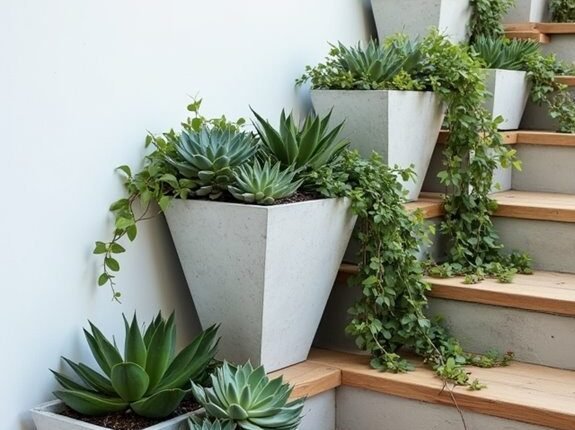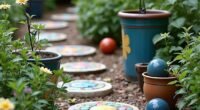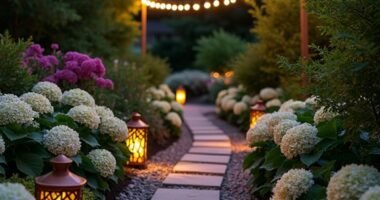You’ll transform your garden with these stylish planter options: vintage wheelbarrows, macramé hangers, upcycled rain boots, tiered terracotta arrangements, living walls, ladder stands, woven baskets, metal sculptures, and seasonal window boxes. Each brings unique character while maximizing your space in different ways. Try mixing materials like driftwood for succulents or floating gardens for water features. Your outdoor space will thrive with these creative containers that blend beauty and function.
Key Takeaways
- Vintage wheelbarrows offer rustic charm for cascading flowers while macramé holders maximize vertical space with bohemian flair.
- Upcycled rain boots create whimsical garden focal points when displayed creatively on steps or garden paths.
- Tiered terracotta arrangements create vertical interest with water-efficient systems as runoff flows from upper to lower pots.
- Living wall installations transform bare spaces while providing insulation, reducing noise pollution, and attracting beneficial insects.
- Driftwood hollows planted with succulents combine natural textures with geometric plant forms for striking visual contrast.
Vintage Wheelbarrow Garden Displays
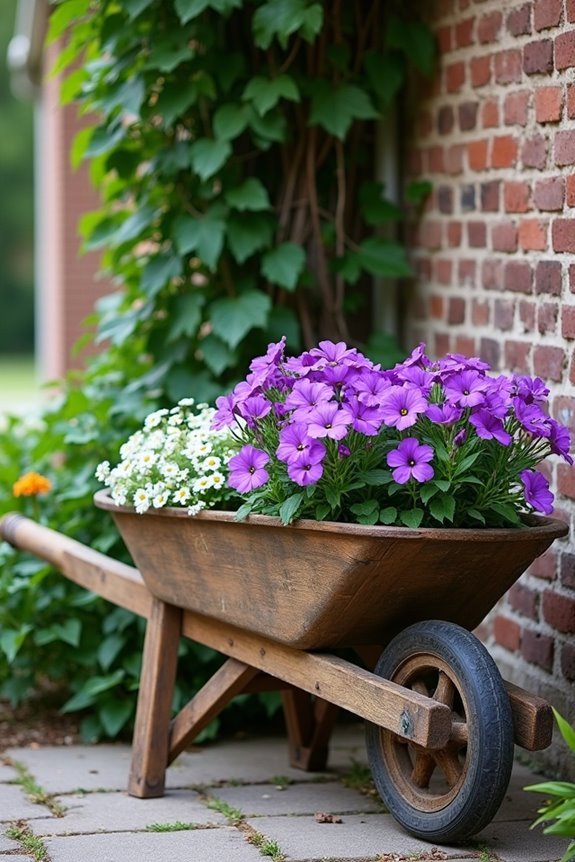
While many gardeners focus solely on traditional planters, vintage wheelbarrows offer a charming, rustic alternative that can transform your outdoor space. These wheeled treasures create an instant focal point in any garden, combining history and functionality in one beautiful display.
You’ll find that wheelbarrows work wonderfully for cascading flowers like petunias, lobelia, and sweet alyssum, which can spill over the edges in a colorful waterfall effect. For the best results, drill a few drainage holes in the bottom if they’re not already present, and line the interior with landscape fabric before adding soil. Consider placing your wheelbarrow near an outdoor kitchen area to add visual interest while entertaining guests.
Don’t worry about finding a perfect specimen—a bit of rust or weathering only adds to the character! Position your wheelbarrow planter where it catches the eye, perhaps at the entrance to your garden or along a pathway. Consider complementing your vintage wheelbarrow with modern garden pots to create an engaging contrast between old and new styles. Adding LED strip lights along the wheelbarrow’s rim can create a magical evening ambiance in your garden.
Hanging Macramé Plant Holders
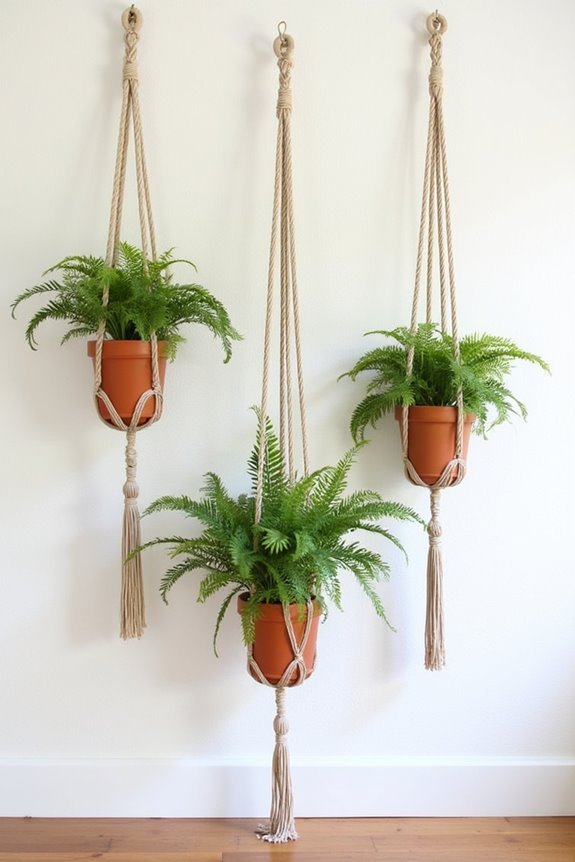
When the garden floor gets crowded with potted plants, looking upward reveals a whole new dimension for your green friends. Hanging macramé plant holders bring a touch of bohemian charm while solving your space dilemma beautifully. Outdoor macrame designs add a stylish element to any exterior space.
You’ll love how these woven beauties sway gently in the breeze, creating visual interest at different heights. Modern macramé comes in various styles, from intricate patterns that showcase craftsmanship to simple designs that let your plants steal the show. They’re perfect for trailing varieties like pothos, spider plants, or string of pearls. Our chic hanging planters elevate any garden space with their elegant designs and versatile mounting options.
Don’t worry if you’re not crafty—many affordable options are available online and in garden centers. For the adventurous, beginner-friendly macramé kits provide everything you’ll need to create your own unique plant hangers, adding a personal touch to your garden sanctuary. Transform your outdoor space with creative macrame planters that add both functionality and artistic flair to your garden decor.
Upcycled Rain Boots as Colorful Planters
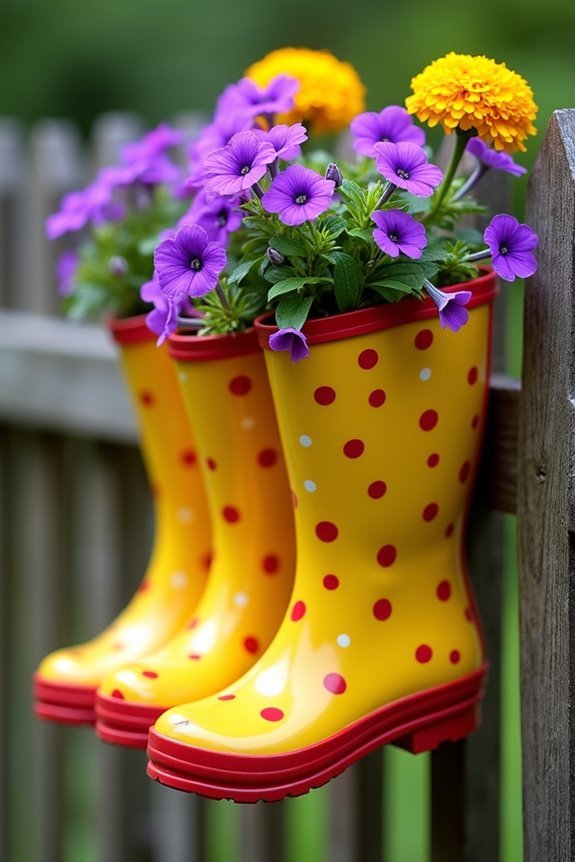
Those colorful rubber boots your family has outgrown don’t have to sit forgotten in the closet—they can bring whimsical charm to your garden as unexpected planters!
To transform boots into planters, first drill several drainage holes in the soles. You’ll want to fill the bottom third with pebbles or broken pottery pieces to guarantee proper drainage. Next, add quality potting soil and select plants that match your boot’s size—try cascading flowers like petunias or lobelia for a lovely draping effect. Just like waterproof outdoor pillows, these planters can withstand various weather conditions. Whether you’re a beginner crafter or seasoned DIY enthusiast, this project offers satisfaction at any skill level.
For display, you can arrange boots on steps, hang them from a fence using sturdy hooks, or create a cheerful family lineup along a garden path. Don’t be afraid to embrace their bright colors, or you can paint plain boots with outdoor-safe paint to match your garden’s palette. They’re perfect for cottage gardens and children’s spaces!
DIY garden planters offer endless possibilities for expressing your personal style while staying within budget.
Tiered Terracotta Pot Arrangements
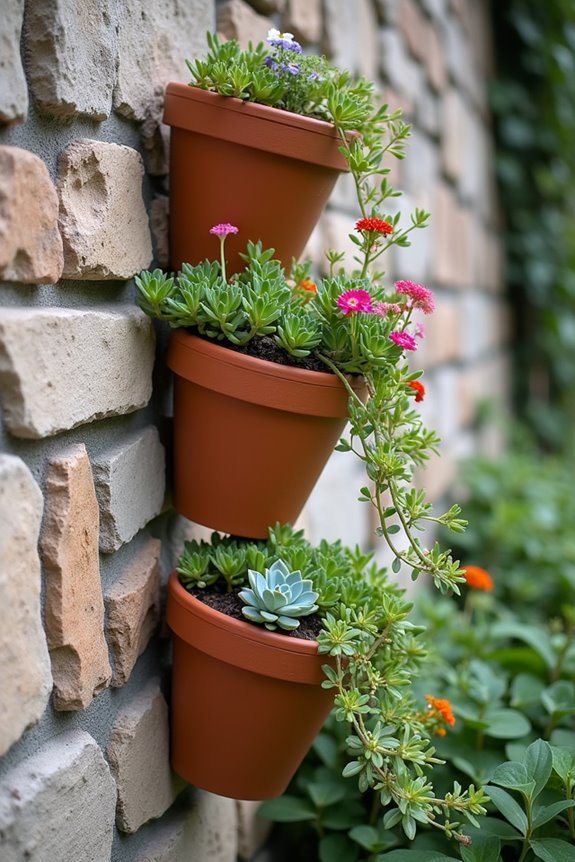
Terracotta pots, with their warm earthy tones and classic appeal, create stunning vertical interest when arranged in tiers throughout your garden. You’ll love how these versatile containers can transform even the smallest spaces into eye-catching displays of greenery and color.
To create your own tiered arrangement, select pots in varying sizes, from large bases to smaller top pieces. Stack them using sturdy plant stands or specially designed pot stackers that guarantee stability. Don’t worry about perfection—slightly offset arrangements often look more natural and appealing.
Fill each level with different plants that complement each other. Try cascading varieties like trailing petunias or ivy for the upper tiers, with fuller plants below. Water carefully, as the runoff from upper pots will reach lower levels, making this arrangement water-efficient too! Consider adding hanging planter baskets between tiers to maximize your vertical gardening potential.
Living Wall Vertical Gardens
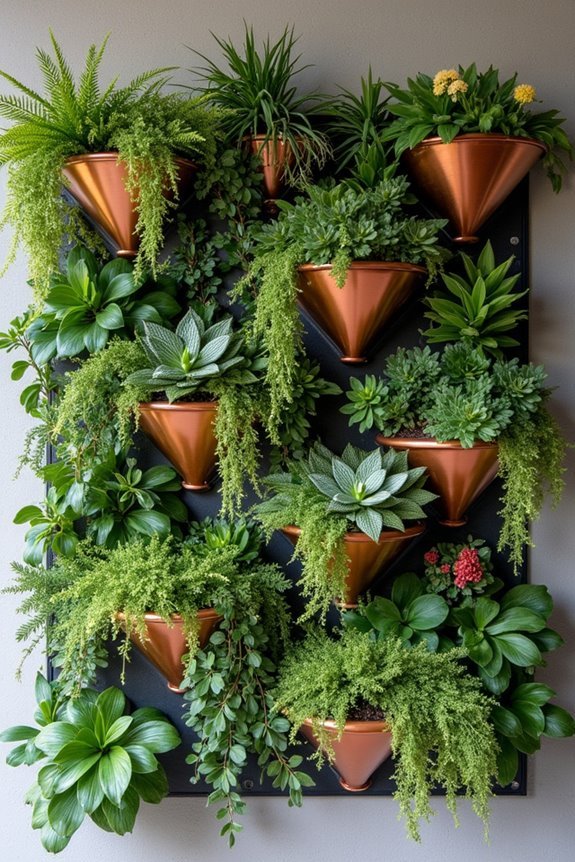
Moving beyond stacked arrangements, living wall vertical gardens have revolutionized the way we think about garden spaces. These stunning green installations transform bare walls into lush, living tapestries that’ll make your outdoor area feel truly special.
You’ll need a sturdy frame system, irrigation setup, and appropriate plant selections to create your vertical masterpiece. Choose varieties that thrive in your climate and consider their growth habits – some plants cascade beautifully while others grow more compactly.
Don’t worry if you’re short on ground space! Living walls work wonderfully on fences, garage exteriors, or even balcony walls. They’re perfect for urban gardeners who want to maximize their growing potential. Best of all, these vertical gardens provide excellent insulation, reduce noise pollution, and create habitats for beneficial insects. You’ll enjoy both beauty and function with this modern gardening approach.
Concrete Geometric Containers
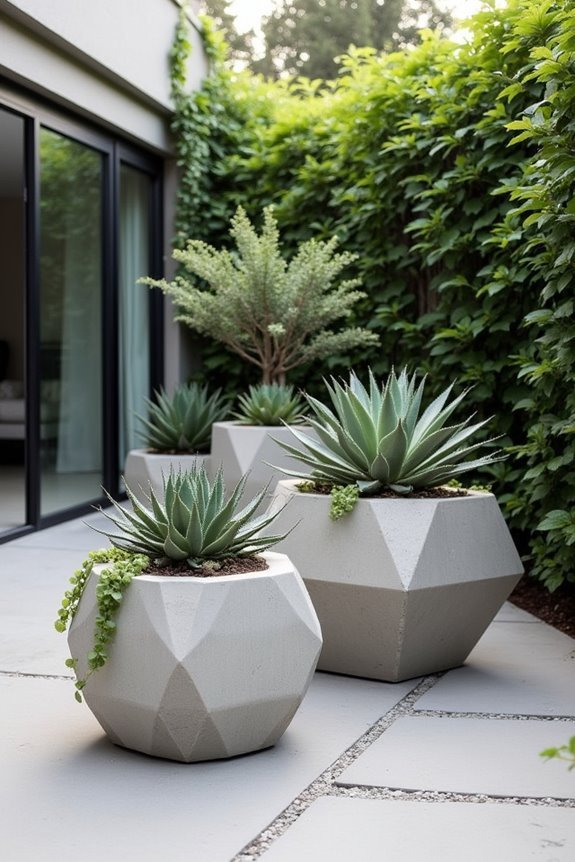
Concrete geometric containers have become a stylish favorite among modern gardeners everywhere. You’ll love how these sturdy planters add clean lines and contemporary flair to your outdoor space, creating a beautiful contrast with the organic shapes of your plants. They’re incredibly versatile, working well in both small balcony gardens and sprawling landscapes.
You don’t need to be a DIY expert to create your own! Simply mix concrete, pour it into molds of different shapes, and let it dry. For a pop of color, try painting portions with outdoor acrylic paint or adding glass tiles to the edges. These containers work beautifully with succulents, ornamental grasses, and trailing plants that soften their angular edges. Best of all, they’ll withstand harsh weather conditions for years to come!
Rustic Wooden Crates for Herbs
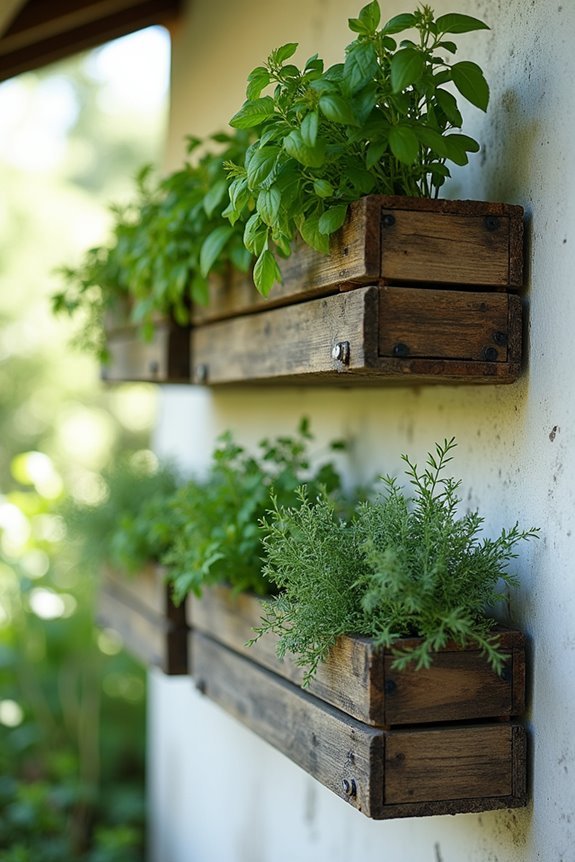
Several rustic wooden crates can transform your herb garden into a charming, functional space that brings warmth to any setting. These versatile containers aren’t just beautiful—they’re practical too, offering excellent drainage for herbs that don’t like wet feet.
You’ll find that wine crates, vintage fruit boxes, or even handmade wooden containers work wonderfully for growing basil, thyme, rosemary, and mint. To prepare your crates, simply drill a few drainage holes in the bottom, add a layer of gravel, and fill with quality potting soil.
For added character, consider sanding and staining your crates, or leave them natural for that perfectly weathered look. Group several crates of different heights on your patio or deck to create a visually interesting display that keeps your favorite cooking herbs within easy reach.
Floating Water Gardens for Ponds
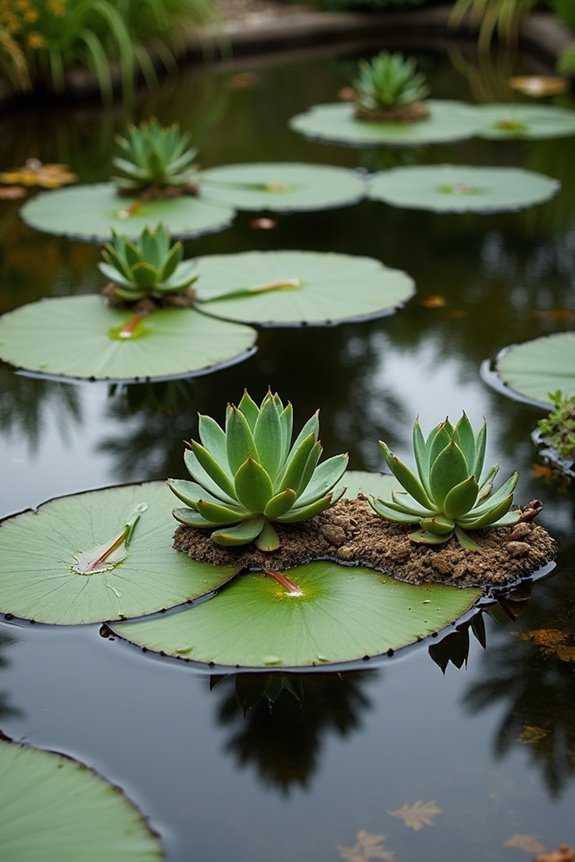
Why not bring the serene beauty of water lilies and floating plants to your backyard pond? Creating a floating garden transforms your water feature into a living canvas of color and texture. You’ll love how these botanical islands create perfect habitats for beneficial insects while naturally filtering your pond water.
Getting started with floating water gardens is easier than you might think:
- Use floating foam rings or repurposed pool noodles as bases for your plant arrangements
- Choose a mix of flowering plants like miniature water lilies alongside trailing greenery for visual interest
- Add water-purifying plants such as water hyacinth to keep your pond naturally clear
Your floating garden will change with the seasons, offering new delights as different plants bloom and evolve throughout the year.
Succulent-Filled Driftwood Planters
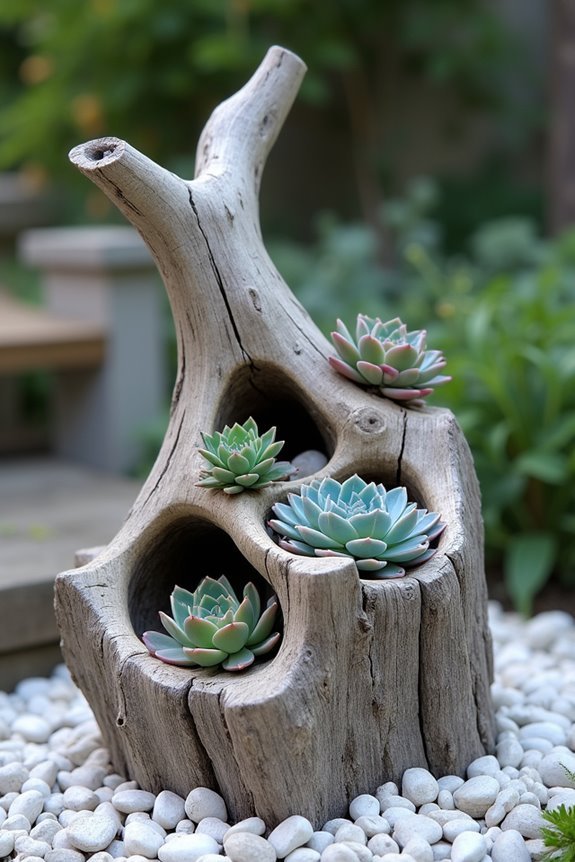
Driftwood’s natural beauty provides an ideal canvas for creating stunning succulent arrangements that will become a mesmerizing focal point in your garden. The weathered texture and unique shapes of driftwood perfectly complement the geometric forms of succulents, creating a display that looks both artistic and natural.
To create your own, start by finding a piece of driftwood with natural hollows or crevices. You’ll want to fill these spaces with a well-draining cactus soil mix before arranging your succulents. Choose a variety of colors, textures, and sizes for visual interest. Small sedums, echeverias, and haworthias work wonderfully for these projects.
Water sparingly, as both the driftwood and succulents prefer drier conditions. You’ll love how these low-maintenance planters bring the beauty of shorelines into your garden sanctuary.
Repurposed Wine Barrel Planters
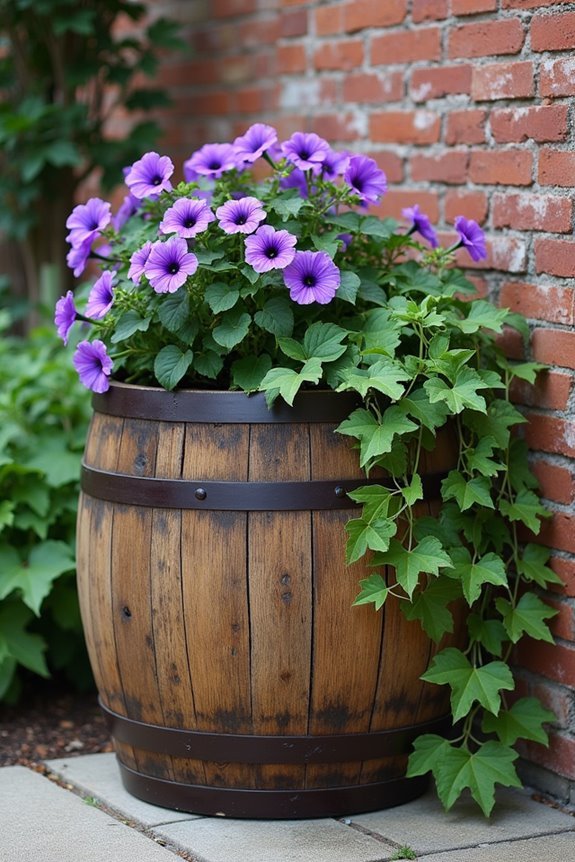
Crafted from the aging vessels of vintners’ craft, wine barrel planters bring rustic elegance to any garden space while giving these wooden containers a second life. You’ll love how these sturdy planters can transform your outdoor area with their natural charm and practical design. They’re perfect for growing everything from colorful annuals to small trees or herbs.
When using wine barrels in your garden, consider:
- Half barrels work wonderfully as standalone features, while whole barrels make dramatic focal points
- Drill drainage holes in the bottom to prevent root rot and guarantee your plants thrive
- Apply a wood sealer to extend your barrel’s life, especially in rainy climates
You don’t need to be a master gardener to create something beautiful with these timeless planters. Their deep roots hold plenty of soil, giving your plants room to grow strong.
Glass Terrarium Showcases
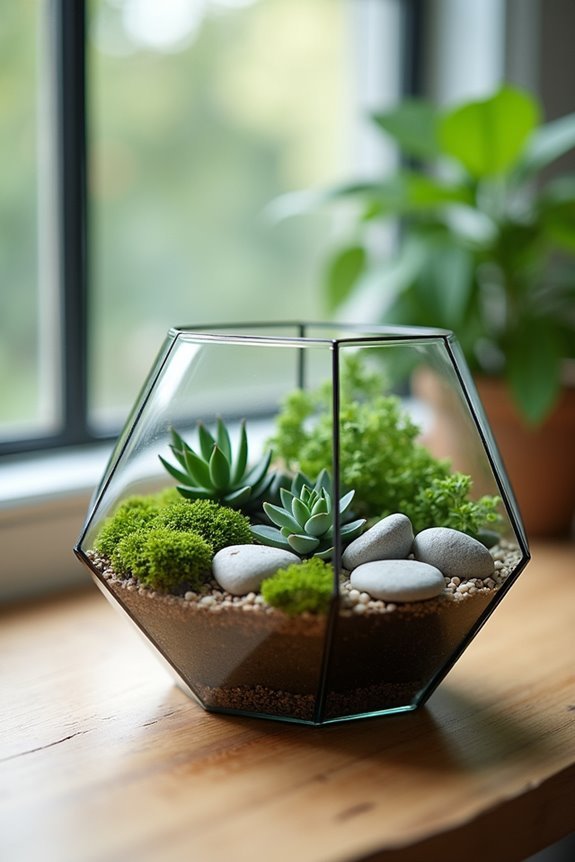
While wine barrels bring rustic charm to your garden, glass terrariums offer a completely different aesthetic that’s equally enchanting. These transparent showcases create miniature worlds that you can observe from every angle, bringing a touch of elegance to indoor or sheltered outdoor spaces.
You’ll find terrariums in various shapes—from geometric designs to hanging globes—each offering a perfect home for moisture-loving plants like ferns, moss, and air plants. What’s wonderful about these glass gardens is how they create their own microclimate, requiring minimal maintenance once established.
To create your own, start with a layer of small pebbles for drainage, add activated charcoal to keep the soil fresh, then top with potting mix. Arrange your tiny plants thoughtfully, adding miniature figurines or colored sand for personal flair.
Ladder Plant Stands for Small Spaces
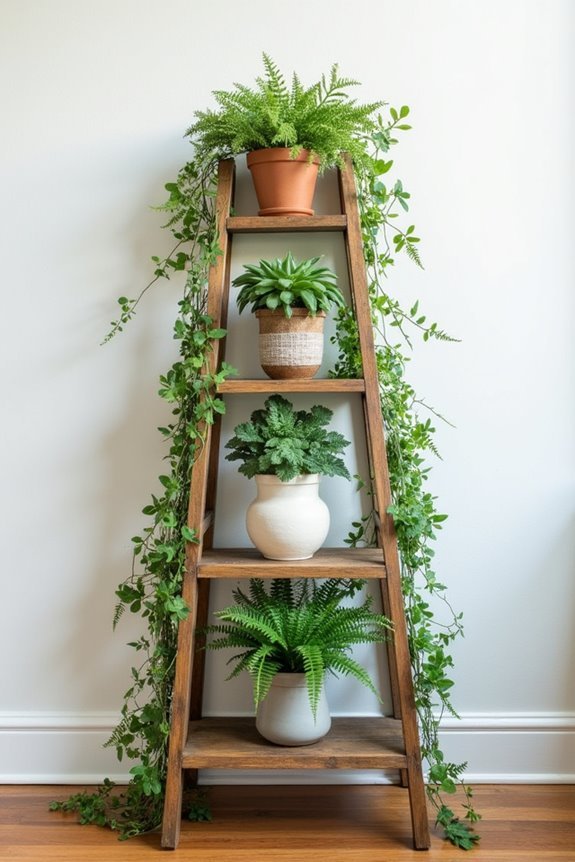
When space comes at a premium in your garden or patio, ladder plant stands offer a brilliant vertical solution that maximizes your growing area without sacrificing style. These charming structures let you display your favorite plants in tiers, creating a stunning visual impact while keeping your footprint small.
You’ll love how ladder stands transform overlooked corners into garden showpieces. They’re perfect for apartments, tiny yards, or anywhere you’re craving more greenery!
- Choose wooden ladders for a rustic, farmhouse feel that complements both indoor and outdoor settings
- Opt for metal designs when you need something weather-resistant and contemporary
- Look for foldable options that you can easily store away during winter months
The best part? You can customize your ladder display seasonally, swapping plants as your garden evolves throughout the year.
Woven Basket Containers With Liners
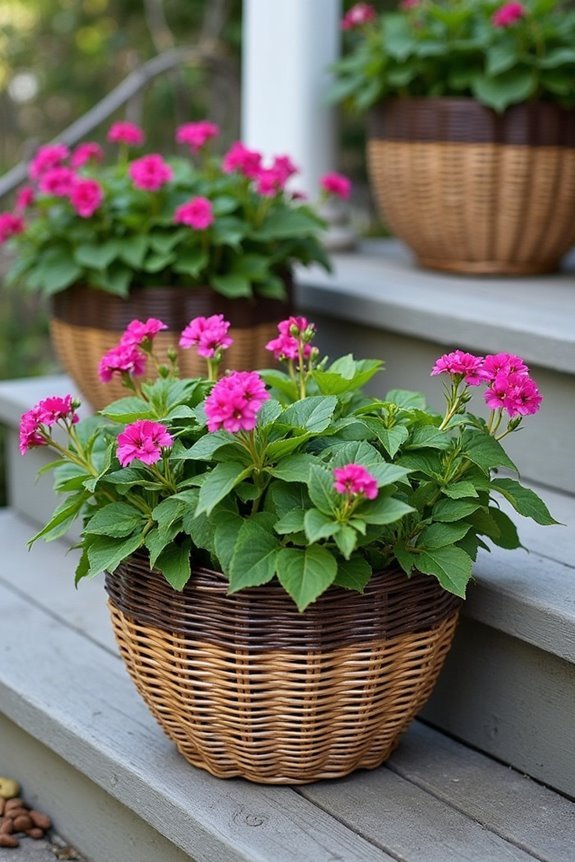
Although natural woven baskets have graced homes for centuries, they’ve recently made a stylish comeback as garden containers that add warmth and texture to any outdoor space. You’ll need to add plastic or fabric liners to protect both your plants and the basket material from moisture damage.
Look for baskets in varied shapes and sizes, from round to oval to square, each bringing unique character to your garden display. The natural fibers, including rattan, seagrass, or water hyacinth, create a beautiful contrast against vibrant greenery.
You can place these versatile containers on patios, arrange them on steps, or hang them from hooks. Don’t hesitate to mix different basket styles together for a collected, bohemian look that makes your garden feel thoughtfully curated and wonderfully inviting.
Sculptural Metal Statement Planters
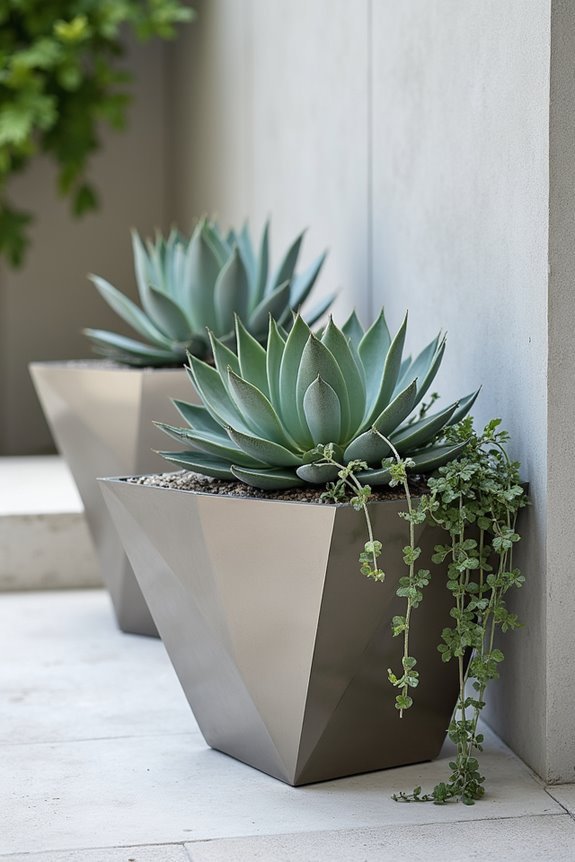
Unlike their softer counterparts, sculptural metal planters make bold artistic statements in any garden space. You’ll find these sturdy containers add year-round structure while creating dramatic focal points. Their weather-resistant qualities mean they’ll look stunning season after season, developing beautiful patinas that only enhance their charm.
Consider these standout options for your garden:
- Weathered Corten steel planters that develop a warm, rusty finish over time, creating beautiful contrast with lush greenery
- Sleek stainless steel containers that reflect light and surrounding plants, making spaces feel larger
- Hammered copper vessels that warm up with rich tones as they age, complementing both modern and traditional gardens
You’ll love how these metal beauties don’t just hold plants—they transform your outdoor space into an artistic expression of your personal style.
Window Box Gardens With Seasonal Themes
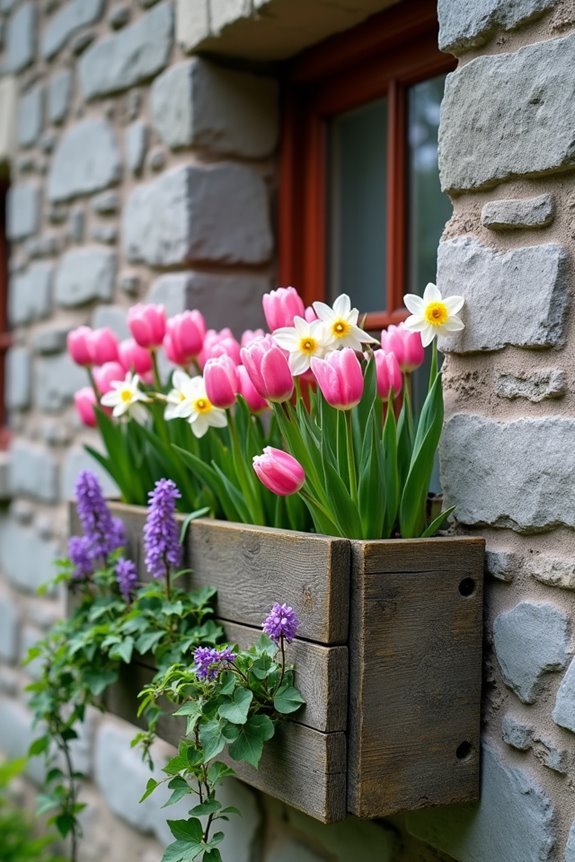
Window box gardens transform ordinary facades into seasonal showcases that change with the calendar. You’ll love how these compact spaces offer endless creative possibilities while adding charm to your home’s exterior.
In spring, fill your boxes with cheerful tulips, daffodils, and pansies that welcome warmer days. Summer calls for cascading petunias, vibrant geraniums, and fragrant herbs that spill beautifully over the edges. When autumn arrives, switch to ornamental kale, mums, and ornamental grasses that capture fall’s rich palette.
Don’t forget winter! Evergreen boughs, holly berries, and cold-tolerant cyclamens keep your window boxes looking festive during colder months. Remember to match your plantings to your home’s style and consider the amount of sunlight each box receives for best results.
Frequently Asked Questions
How Often Should I Water Plants in Different Planter Materials?
Your watering schedule depends on your planter’s material. Clay pots dry out quickly, so you’ll need to water every 2-3 days. Plastic and glazed ceramic planters retain moisture longer, requiring watering only once a week. Metal planters heat up fast, so check soil moisture every 2-3 days. Always feel the soil first—if it’s dry an inch down, it’s time to water your precious plants!
What Soil Mixtures Work Best for Various Planter Types?
You’ll need different soil mixes for various planters to help your plants thrive. For clay pots, use well-draining soil with extra perlite since they retain moisture. Wood planters benefit from soil that holds some moisture, while metal containers need moisture-retaining mixes with compost. Plastic planters work with standard potting soil, and concrete planters do best with a mix that includes sand for drainage and aeration.
Can Indoor Planters Be Safely Moved Outdoors Seasonally?
Yes, you can safely move indoor planters outdoors, but you’ll need to gradually acclimate your plants to avoid shock. Start by placing them in a shaded area for a few hours daily, slowly increasing exposure over 1-2 weeks. Remember, not all plants can handle outdoor conditions, so check your specific varieties first. When fall approaches, reverse the process before bringing them indoors to prevent pest hitchhikers and temperature stress.
How Do I Prevent Drainage Issues in Decorative Containers?
Like a thirsty sponge struggling in a bathtub, your decorative containers need proper drainage to thrive. You’ll want to drill holes in the bottom of non-draining pots, or create a layer of gravel or broken pottery pieces before adding soil. Don’t forget to elevate your containers with pot feet or stones, allowing water to escape freely. When using saucers indoors, empty them after watering so your plants aren’t left soaking in a miniature pond.
Which Plants Thrive in Shallow vs. Deep Planter Designs?
Shallow planters are perfect for succulents, herbs, and ground covers since they have smaller root systems. You’ll love how these plants spread beautifully without needing much soil depth. Deep planters, on the other hand, support root vegetables, tomatoes, and larger ornamentals that need room to anchor themselves. When choosing containers, always match the plant’s root needs with the planter’s depth for thriving, happy plants in your garden!
